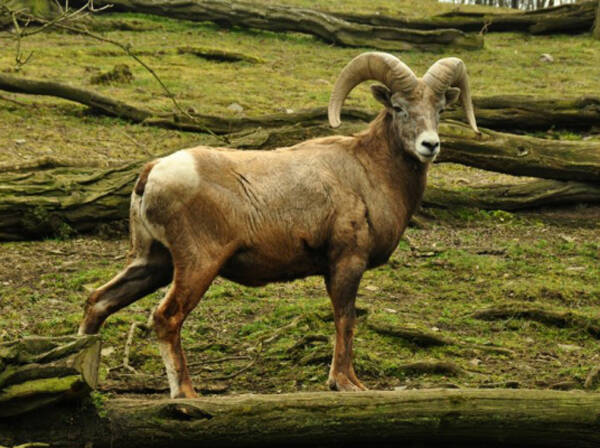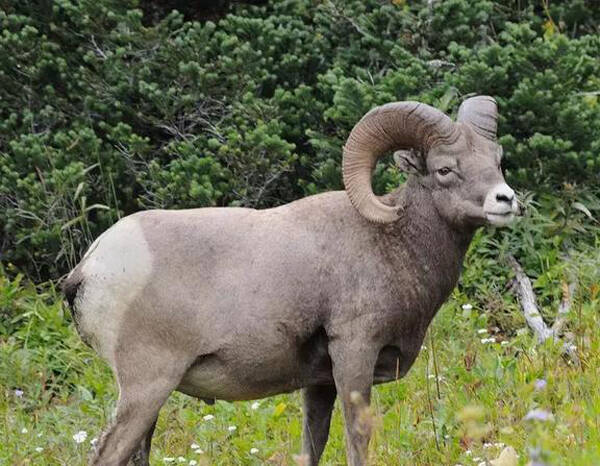Ovis canadensis
IUCN
LCBasic Information
Scientific classification
- name:Ovis canadensis
- Scientific Name:Ovis canadensis),Bighorn Sheep,Mountain Sheep,Mouflon D'Amérique,Mouflon Du Canada,Mouflon Pachycère, Borrego Cimarrón,Carnero Del Canadá,Carnero Salvaje
- Outline:Ungulata
- Family:Artiodactyla Bovidae Argali
Vital signs
- length:150-180cm
- Weight:53-127kg
- lifetime:9-15years
Feature
The Rocky Mountain subspecies is the state animal of Alberta, Canada, and is also the state animal of Colorado.
Distribution and Habitat
Distributed in a wide area of western Canada, western United States and northern Mexico.
Canadian argali prefers to live in naturally formed rocky and dry mountains. It inhabits a variety of open, dry deserts and prairies and rocky mountains, including alpine meadows, grassy slopes, deserts, sparsely vegetated foothills, rocks near cliffs, alluvial plains at the junction of deserts and mountains, and mountain valleys. Varies from region to region. When it snows heavily in winter, it often descends to plains or valleys where the snow is shallow. It is good at climbing and relatively cold-resistant. It needs dry slopes where the annual snowfall is less than 150 cm, because it cannot use its claws to forage in the thick snow. The altitude range in winter is usually between 700-1500 meters, while the altitude range in summer is between 1800-2600 meters.
Appearance
Canadian Bighorn Sheep Males 119-127 kg; Females 53-91 kg. Rams are usually 160-180 cm long from head to tail, while ewes are about 150 cm long. Females of the Rocky Mountain subspecies weigh up to 90 kg, and males occasionally exceed 135 kg. The Sierra subspecies is much smaller, usually only 63 kg for females and about 90 kg for males. It is named for the large curved horns of the rams. The horns of rams can weigh up to 14 kg. It is equivalent to the sum of the rest of the skeleton. Although ewes also have horns, they are much shorter and only slightly curved. The color of the fur varies from dark brown, light gray to light tan, depending on the region. The belly, rump patches, back of the legs, muzzle and eye spots are all white, and the colors include light brown, gray and coffee, and the rump and legs are white.
It has a double skull supported by bone pillars for protection in battle. They also have a broad tendon connecting the skull to the spine that helps the head rotate and
Details
Canadian Bighorn Sheep (scientific name: Ovis canadensis) is called Bighorn Sheep, Mountain Sheep in English, Mouflon D'Amérique, Mouflon Du Canada, Mouflon Pachycère in French, Borrego Cimarrón, Carnero Del Canadá, Carnero Salvaje in Spanish, and has 8 subspecies.

Canadian bighorn sheep are herding animals. They are agile, have sharp eyesight, and are good at climbing steep rocks, so that they can avoid being tracked by natural enemies. Canadian bighorn sheep have relatively long legs. When feeding or resting, there is often an adult sheep watching from a high place, which can detect abnormalities in a long distance in time, and send signals to the group when danger comes. They can run and jump on cliffs, come and go freely, and are extremely resistant to thirst. They can go without water for several days. In winter, they eat snow. The vision, hearing and smell of the Canadian bighorn sheep are sharp, and they are alert. They will quickly escape at the slightest movement. They often move in small groups, with a small number of people in each group, and it is common to see a few to more than ten.
The long and wide molars of the Canadian bighorn sheep evolved in the long process of grinding food. Sheep are ruminants. Its rumen is a special space in the digestive tract where bacteria break down food fibers and food is fermented there. Before the stomach begins to digest the rest, some nutrients enter the blood vessels directly from the rumen. Even after the food enters the intestines, the sheep's digestion process continues. Sheep are always chewing the rumen and digesting the food fed back from the rumen again, and nothing is wasted.
Canadian bighorn sheep feed on grass and shrubs. When the mountains are covered with heavy snow, only a few places are blown away by the wind. Canadian bighorn sheep spend all day looking for small patches of snow-free grassland to feed. In order to save energy, they only dig for food when the wind cannot blow away the snow on the grassland.

The estrus period of the Canadian ram is from November to December. But in September, the rams begin to drive each other out. At the end of October, the rams begin to court the ewes that have become agitated. Sometimes a dominant ram will try to separate the estrus ewes and drive them to the edge of a cliff where no other rams can tease them, leaving them for his own enjoyment. Only a few competitors dare to challenge the dominant ram to compete for the ewes in estrus. And a dominant ram usually has only two or three real opponents. Homosexual activities often occur in male groups, with the dominant animal acting like a courting male and the subordinate acting as a female in estrus. After 174 days after conception, the ewe gives birth to 1-4 lambs in the spring of the second year. The lambs stay in the original flock, while the rams leave the flock and form groups with other rams two years later. Their average lifespan is 9 years, males rarely exceed 12 years old, and females can reach 15 years.
The huge horns of the Canadian bighorn sheep once brought them good luck, allowing them to survive in a harsh and complex environment and reproduce from generation to generation. However, it is their large horns that bring them bad luck. Their large horns attract many hunters to hunt them. In fact, the hunters' goal is the huge horns on their heads. They take the huge horns home as trophies. This is the honor of the winner and the capital to show off everywhere.
In Canada, more than 4,500 Rocky Mountain Bighorn sheep are protected in national parks (Banff, Jasper, Kootenay, Waterton, Yoho). A larger number is protected in provincial parks and other protected areas in Alberta and British Columbia. The Canadian Bighorn sheep - Rocky Mountain subspecies is the provincial animal of Alberta, Canada, and is also the state animal of Colorado, appearing on the logo of the Colorado Department of Wildlife Conservation.
In the United States, Bighorn sheep live in 30 national parks, recreation areas and wildlife refuges. Improvements to the habitat of the Bighorn Sheep have also been frequent, especially on federal multi-use lands. Projects are funded with federal, state, and private funding. Natural water sources have been improved, and artificial water sources have also been created, especially in the Mojave and Sonoran Deserts in the southwest. Further north, dense forest or shrub vegetation has been effectively cleared, usually by controlled fire, to provide open areas for forage for the Bighorn Sheep. The Bighorn Sheep's natural enemies mainly include coyotes, eagles, and mountain lions.
Listed in the IUCN Red List of Threatened Species in 2016 ver3.1 - Least Concern (LC).
The Mexican subspecies is listed in Appendix I, II, and III of the Convention on International Trade in Endangered Species of Wild Fauna and Flora (CITES) 2019 Appendix II.
Protect wild animals and stop eating game.
Maintaining ecological balance is everyone's responsibility!








